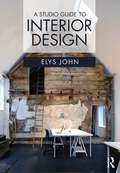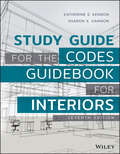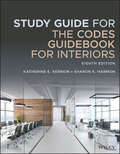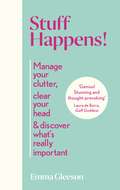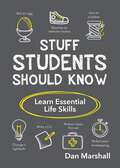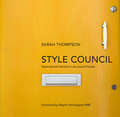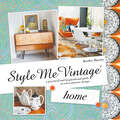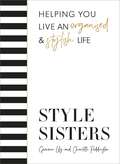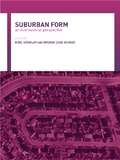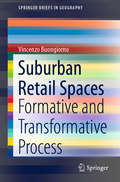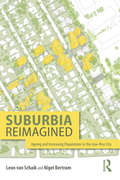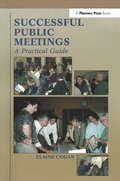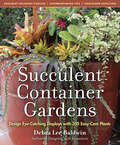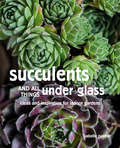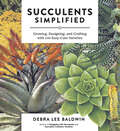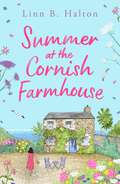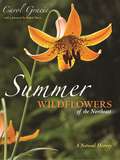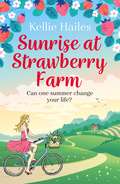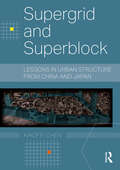- Table View
- List View
A Studio Guide to Interior Design
by Elys JohnA Studio Guide to Interior Design leads you through the creative process of developing an interior design proposal. From reading existing buildings, to presenting the final design, each stage is illustrated with analytical diagrams demonstrating clearly the workflow, processes and skills needed at each stage of the design process. Throughout the book there are key references to drawing, digital practice, author illustrated diagrams and design precedents. The book shows how to effectively read existing architecture and interiors and sets out orthographic drawing principles, to be used as an integral part of conceptual design development. It also looks at the integration of technology within the design process. The book has a complementary focus towards hand drawing and digital practice and uses a case study driven, diagrammatic approach so students can readily apply programmatic concepts to their own project context. Ideally suited to students at the beginning of their course, the book covers everything students need to get to grips with early on in their studies and features a wealth of pedagogical features.
A Studio Guide to Interior Design
by Elys JohnA Studio Guide to Interior Design leads you through the creative process of developing an interior design proposal. From reading existing buildings, to presenting the final design, each stage is illustrated with analytical diagrams demonstrating clearly the workflow, processes and skills needed at each stage of the design process. Throughout the book there are key references to drawing, digital practice, author illustrated diagrams and design precedents. The book shows how to effectively read existing architecture and interiors and sets out orthographic drawing principles, to be used as an integral part of conceptual design development. It also looks at the integration of technology within the design process. The book has a complementary focus towards hand drawing and digital practice and uses a case study driven, diagrammatic approach so students can readily apply programmatic concepts to their own project context. Ideally suited to students at the beginning of their course, the book covers everything students need to get to grips with early on in their studies and features a wealth of pedagogical features.
Study Guide for The Codes Guidebook for Interiors: Wiley E-text Folder And Interactive Resource Center Access Card
by Katherine E. Kennon Sharon K. HarmonThe comprehensive study guide for understanding interior codes This revised and updated seventh edition of the Study Guide for the Codes Guidebook for Interiors is an essential companion to The Codes Guidebook for Interiors, the industry's reference of choice, with complete coverage of the major codes and standards that apply to interior projects. This Study Guide includes term lists, practice questions, practical application exercises, code tables, checklists, and a book companion site featuring interactive checklists, helping designers and architects check their knowledge and comprehension from reading The Codes Guidebook for Interior chapters and prepare for the NCIDQ and ARE exams. Since The Codes Guidebook for Interiors text covers the latest requirements, standards, terminology, and federal regulations, including the 2015 ICC, the current ADA standards, and ICC/ANSI requirements as well as information on green construction, this companion study guide is a comprehensive measure of designers understanding and application of codes for interior projects. It can help design students learn and practitioners keep their skills up to date. Because it is vital that designers and architects have an up-to-date working knowledge of the various codes involved with building interiors, whether during renovation or new construction, the study guide offers them an opportunity to: Check their knowledge of the key terms of the industry Test their working knowledge of codes using the practice questions and problem scenarios Utilize the code tables during the design process Employ the numerous checklists on proposed and real life projects to ensure complete compliance The revised Study Guide is a useful companion to The Codes Guidebook for Interiors, the essential reference for all interior professionals. Check your understanding of the individual chapters as exam prep or even just as a self-test. For the designer, architect, or student, the Study Guide for The Codes Guidebook for Interiors is a must-have resource.
Study Guide for The Codes Guidebook for Interiors
by Katherine E. Kennon Sharon K. HarmonThe comprehensive study guide for understanding interior codes This revised and updated seventh edition of the Study Guide for the Codes Guidebook for Interiors is an essential companion to The Codes Guidebook for Interiors, the industry's reference of choice, with complete coverage of the major codes and standards that apply to interior projects. This Study Guide includes term lists, practice questions, practical application exercises, code tables, checklists, and a book companion site featuring interactive checklists, helping designers and architects check their knowledge and comprehension from reading The Codes Guidebook for Interior chapters and prepare for the NCIDQ and ARE exams. Since The Codes Guidebook for Interiors text covers the latest requirements, standards, terminology, and federal regulations, including the 2015 ICC, the current ADA standards, and ICC/ANSI requirements as well as information on green construction, this companion study guide is a comprehensive measure of designers understanding and application of codes for interior projects. It can help design students learn and practitioners keep their skills up to date. Because it is vital that designers and architects have an up-to-date working knowledge of the various codes involved with building interiors, whether during renovation or new construction, the study guide offers them an opportunity to: Check their knowledge of the key terms of the industry Test their working knowledge of codes using the practice questions and problem scenarios Utilize the code tables during the design process Employ the numerous checklists on proposed and real life projects to ensure complete compliance The revised Study Guide is a useful companion to The Codes Guidebook for Interiors, the essential reference for all interior professionals. Check your understanding of the individual chapters as exam prep or even just as a self-test. For the designer, architect, or student, the Study Guide for The Codes Guidebook for Interiors is a must-have resource.
Study Guide for The Codes Guidebook for Interiors
by Katherine E. Kennon Sharon K. HarmonSTUDY GUIDE FOR THE CODES GUIDEBOOK FOR INTERIORS The comprehensive study guide for understanding interior codes This revised and updated eighth edition of the Study Guide for the Codes Guidebook for Interiors is an essential companion to The Codes Guidebook for Interiors, the industry’s reference of choice. It offers complete coverage of the major codes and standards that apply to interior projects. This Study Guide includes lists of terms, practice questions, practical application exercises, code tables, and checklists. This companion study guide is a comprehensive measure of a designer’s understanding and application of codes for interior projects. It can help design students learn and practitioners keep their skills up to date and prepare for the NCIDQ and ARE exams. It is vital that designers and architects have an up-to-date working knowledge of the various codes involved with building interiors, whether during renovation or new construction, and this study guide offers the opportunity to: Study with many new questions, in both the short answer and application sections Review the key terms of the industry Use the practice questions and exercises to test working knowledge of codes Utilize the code tables during the design process Employ the numerous checklists on proposed and real life projects to ensure complete compliance The revised Study Guide is a useful companion to The Codes Guidebook for Interiors, the essential reference for all interior professionals. For the designer, architect, or student, the Study Guide for The Codes Guidebook for Interiors is a must-have resource.
Study Guide for The Codes Guidebook for Interiors
by Katherine E. Kennon Sharon K. HarmonSTUDY GUIDE FOR THE CODES GUIDEBOOK FOR INTERIORS The comprehensive study guide for understanding interior codes This revised and updated eighth edition of the Study Guide for the Codes Guidebook for Interiors is an essential companion to The Codes Guidebook for Interiors, the industry’s reference of choice. It offers complete coverage of the major codes and standards that apply to interior projects. This Study Guide includes lists of terms, practice questions, practical application exercises, code tables, and checklists. This companion study guide is a comprehensive measure of a designer’s understanding and application of codes for interior projects. It can help design students learn and practitioners keep their skills up to date and prepare for the NCIDQ and ARE exams. It is vital that designers and architects have an up-to-date working knowledge of the various codes involved with building interiors, whether during renovation or new construction, and this study guide offers the opportunity to: Study with many new questions, in both the short answer and application sections Review the key terms of the industry Use the practice questions and exercises to test working knowledge of codes Utilize the code tables during the design process Employ the numerous checklists on proposed and real life projects to ensure complete compliance The revised Study Guide is a useful companion to The Codes Guidebook for Interiors, the essential reference for all interior professionals. For the designer, architect, or student, the Study Guide for The Codes Guidebook for Interiors is a must-have resource.
Stuff Happens!: Manage your clutter, clear your head & discover what's really important
by Emma GleesonLife is messy, and sometimes so is your space.As a reformed hoarder turned professional declutterer, Emma Gleeson knows how easy it is to be overwhelmed by stuff. Stuff Happens! is her life-changing guide to getting a handle on your stuff and reclaiming your peace of mind.Stuff Happens! is brimful of practical advice on . . .· what to keep and what to chuck (responsibly)· how to shop (especially if you struggle with a fast fashion habit)· how to organize (however tiny your space)Stuff Happens! is packed with clever room-by-room pointers and ingenious tips and hacks.Not only that, it will change your relationship with stuff forever. By putting you, rather than some dream of minimalism, at the heart of the process Emma explains that it's natural to have stuff and easier than you think to stop it getting out of control.Filled with aha moments from Emma's and her clients' lives, and fantastic tools for making lasting change, Stuff Happens! will transform both your space and your headspace - so that you can focus on what's really important._______________'Genius! Stunning and thought-provoking' Laura de Barra, author of Gaff Goddess'So well thought out, practical and personal' Emer McLysaght'Simply brilliant. I find myself returning to it again and again' Hilary Fannin 'Fab! As a total hoarder and un-organiser, Stuff Happens! is what the doctor ordered' James Kavanagh 'Not just practical, I loved how brilliantly Emma explained the psychology behind so many common problems we all have in dealing with our stuff' Daniella Moyles, author of Jump
Stuff Students Should Know: Learn Essential Life Skills
by Dan MarshallCan you make a healthy meal? Do you know how to proofread an essay? Are you able to plan a weekly budget? If the answer to any of the above is no, then don’t worry – you’re like the millions of other students worldwide! Luckily this book is here to give you a crash course in living while you learn. Full of useful advice and practical skills, it will provide you with the essential knowledge you need to take your first steps into the world of adulthood. From the little things, like planning a revision timetable, right up to the big, like negotiating your starting salary, this handy guide will arm you with all the skills you need to navigate life in the real world like a pro.
Style Council: Inspirational Interiors in Ex-Council Homes
by Sarah ThompsonWith a foreword by Wayne Hemingway MBE and an introduction by Catherine Croft, director of the Twentieth Century Society, Style Council brings together an inspirational and eclectic selection of interiors from a generation of homeowners who are redefining the status of local-authority architecture. From covetable apartments in hip Brutalist high-rises to rural cottages with roses around the door, Style Council peeks behind the curtains of the often unappreciated former council home, into the lives of the creative and resourceful people who live there. The homes featured are unique, yet bound by an upcycling ethos, an innate sense of style and the triumph of dash over cash. Style Council is an essential sourcebook and a goody-bag of ideas for anyone wanting to do up their home – ex-council or not – in style.The book features 15 homes across the UK, with full-colour interior photography by Sarah Cuttle.
Style Me Vintage: A Practical And Inspirational Guide To Retro Interior Design (Style Me Vintage Ser.)
by Keeley HarrisCelebrating the perennial interest in incorporating vintage flea-market finds into interior schemes, Style Me Vintage: Home is a feast of retro inspiration. With practical information on how to identify and source original vintage homewares, there is also plenty of inspiration on how to style your rooms according to your favoured decade, whether it be the 1920s or the 1970s. Without being restrictive, there's also plenty of advice on how to mix eras and incorporate vintage into contemporary schemes. This is a sourcebook of inspiration to all those hungry for nostalgic design. From ideas for display (fab sixties artwork, kitsch figurines, retro plates and crockery) to larger furniture finds (fifties sideboards, classic fabrics, reupholstered armchairs) see how vintage design can be made to work today.
Style Sisters: Helping you live an organised & stylish life
by Charlotte Reddington Gemma Lilly'This book is an absolute must-have - add style, organization and a whole sense of calm to your home with their amazing advice.' - Amanda HoldenJust two years ago, busy mums Gemma and Charlotte decided to join their fashion and interior heads together to form a unique service to organise homes with some serious style. In their debut book, Style Sisters, they show us how to stylishly rearrange and declutter our homes to reap the incredible visual and emotional benefits.The Style Sisters will take you through your home room by room, showing you how to declutter, organise and style it with ease. Their aim is to make you feel good, equip you with the timeless approach to cutting out the clutter that weighs you down and make room for clarity, space and zen, amidst a non-stop modern life where it's nearly impossible to fit anything in.Packed with Gemma and Charlotte's top tips and tricks, home hacks, timed detox challenges and a sprinkling of their personal hilarious and heart-warming anecdotes from their job, Style Sisters will put you on the path to living a stylish and organised life.'Style Sisters came into our house, helped make it a home and changed our lives for the better. They are so brilliant at what they do.' - Rochelle Humes'I am obsessed by everything these girlies do. They have so many space-saving and organizing tips that you just don't think of yourself.' - Vogue Williams
Suburban Form: An International Perspective
by Brenda Case Scheer Kiril StanilovThis book examines and documents the remarkable development and transformation of suburban form throughout the globe during the twentieth century. The premise that suburban areas are monotonous, inert environments is put to a test through investigation of the complexity of those suburban settings and the dynamic physical changes that have taken place since their inception.
Suburban Form: An International Perspective
by Kiril Stanilov Brenda Case ScheerThis book examines and documents the remarkable development and transformation of suburban form throughout the globe during the twentieth century. The premise that suburban areas are monotonous, inert environments is put to a test through investigation of the complexity of those suburban settings and the dynamic physical changes that have taken place since their inception.
Suburban Retail Spaces: Formative and Transformative Process (SpringerBriefs in Geography)
by Vincenzo BuongiornoThis book derives from observations of the contemporary built environment and its contradictions. The suburban retail spaces, specifically the suburban shopping mall, and the changes caused by them within urban organisms are the object of the investigation synthesized in the volume. The topic is very crucial for the development of the contemporary city. It constitutes at the same time a problem (large commercial structures' spread is 'destroying' traditional commercial urban fabrics) and an opportunity (shopping malls are the most vital parts of the new suburbs and can play the role of community nucleus in urban and suburban areas). Furthermore, the spread of e-commerce forces these structures to functional and spatial transformations that brings also a new relationship with the city.The analytical reading, supplemented by generative and design projections, is carried out by using the conceptual and methodological tools of urban morphology, specifically those of the typological processual approach. From this specific point of view, the suburban shopping mall is read as an organism (a complex system characterized by mutual solidarity and interdependence among component elements) in itself, and as a sub-organisms belonging to the largest territorial organism.The book is intended to offer, to operators, scholars, researchers, professionals and students, a reading and design method, to interpret an important aspect of the contemporary built environment by analyzing the suburban commercial space case. It offers at the same time a model applicable to other specific not-commercial cases, to defining paths for further research and design developments.
Suburbia Reimagined: Ageing and Increasing Populations in the Low-Rise City
by Leon van Schaik Nigel BertramWorldwide, more and more people are living in cities, with suburbs conceived as appendages to the city, rather than being part of the city system, which is densely populated and offers a full range of services. But suburbs are not the city spread too thin, and in fact hold potential for a lived complexity as satisfying as that assumed to be available in inner cities. Just as the ecological function of wetlands was ignored by modernist planning, and swamps once-drained are now recognised as vital to water cycles, suburbs are increasingly recognised as part of a city’s wellbeing with their own alternative ideology and opportunities for urbanity and ecological sustainability. Suburbia Reimagined shows how such subdivision structures can offer new possibilities for sustainably integrating living between generations and between established and arriving migrant communities. The authors worked locally and internationally with university campuses, shopping centres, hospitals, airports, and other large entities spread through suburbia, to identify a broad range of suburban situations that have been modified to ensure that residents have a full access to amenities and services. The book addresses the history and design of suburbia, from the post-war soldier settlements of the 40s and 50s to the university hinterlands of Silicon Valley in order to reappraise the locked potential within such subdivision patterns. The authors propose a new model forward, examining case studies ranging from repurposed malls and railways for ecological sustainability to cul-de-sacs as social units and post-industrial factory conversions, ultimately showing the nascent patterns in suburbia that have the potential to support a rich life for all age groups.
Suburbia Reimagined: Ageing and Increasing Populations in the Low-Rise City
by Leon van Schaik Nigel BertramWorldwide, more and more people are living in cities, with suburbs conceived as appendages to the city, rather than being part of the city system, which is densely populated and offers a full range of services. But suburbs are not the city spread too thin, and in fact hold potential for a lived complexity as satisfying as that assumed to be available in inner cities. Just as the ecological function of wetlands was ignored by modernist planning, and swamps once-drained are now recognised as vital to water cycles, suburbs are increasingly recognised as part of a city’s wellbeing with their own alternative ideology and opportunities for urbanity and ecological sustainability. Suburbia Reimagined shows how such subdivision structures can offer new possibilities for sustainably integrating living between generations and between established and arriving migrant communities. The authors worked locally and internationally with university campuses, shopping centres, hospitals, airports, and other large entities spread through suburbia, to identify a broad range of suburban situations that have been modified to ensure that residents have a full access to amenities and services. The book addresses the history and design of suburbia, from the post-war soldier settlements of the 40s and 50s to the university hinterlands of Silicon Valley in order to reappraise the locked potential within such subdivision patterns. The authors propose a new model forward, examining case studies ranging from repurposed malls and railways for ecological sustainability to cul-de-sacs as social units and post-industrial factory conversions, ultimately showing the nascent patterns in suburbia that have the potential to support a rich life for all age groups.
Successful Public Meetings, 2nd ed.: A Practical Guide
by Elaine CoganThe author explains why it's essential to begin the preparations by deciding what the meeting is intended to accomplish. That, in turn, determines what kind of meeting you should conduct: informational, advisory, or problem-solving. The author breaks down the essential tasks involved and even suggests the right type of person to handle each one. She describes various types of troublesome meeting attendees-from accusers and apathetics to fence-sitters and know-it-alls-and offers advice on how to deal tactfully but firmly with them all. The author also tackles working effectively with the media, a subject that terrifies most planners. True stories of public meetings, both good and bad, add humor to her no-nonsense narrative. Follow her step-by-step checklist and leave nothing to chance."
Successful Public Meetings, 2nd ed.: A Practical Guide (Jossey-bass Public Administration Ser.)
by Elaine CoganThe author explains why it's essential to begin the preparations by deciding what the meeting is intended to accomplish. That, in turn, determines what kind of meeting you should conduct: informational, advisory, or problem-solving. The author breaks down the essential tasks involved and even suggests the right type of person to handle each one. She describes various types of troublesome meeting attendees-from accusers and apathetics to fence-sitters and know-it-alls-and offers advice on how to deal tactfully but firmly with them all. The author also tackles working effectively with the media, a subject that terrifies most planners. True stories of public meetings, both good and bad, add humor to her no-nonsense narrative. Follow her step-by-step checklist and leave nothing to chance."
Succulent Container Gardens: Design Eye-Catching Displays with 350 Easy-Care Plants
by Debra Lee BaldwinWhether your goal is a gorgeous potted garden for a sunny windowsill or outdoor living area—or simply making great gifts—this is a comprehensive primer using succulents to create vibrant, living works of art.
Succulents and All things Under Glass: Ideas And Inspiration For Indoor Gardens
by Isabelle PalmerTransform your home with more than 25 innovative and inspiring ideas using succulents and terrariums to create beautiful and stylish indoor gardens.
Succulents Simplified: Growing, Designing, and Crafting with 100 Easy-Care Varieties
by Debra Lee BaldwinSucculents Simplified is a complete primer on choosing, growing and designing with succulents.
Summer at the Cornish Farmhouse (Escape to Cornwall)
by Linn B. HaltonFrom the bestselling author of Christmas at The Highland Flower Shop writing as Lucy Coleman, comes a brand new series set in a Cornish Farmhouse.When Jess Newman married the love of her life Ben she was sure they had what it took to stay together forever. So when Ben falls out of love with her only to promptly fall in the arms of new girlfriend, Naomi, she really doesn't know how to come to terms with their divorce.Thankfully Jess's granddad, Gabe, has the perfect place for Jess and her eight-year-old daughter Lola to start afresh when he hands them the keys to his holiday home in Cornwall, a beautiful albeit rundown farmhouse – the fresh countryside air, the saffron buns and the seaside breeze might just be what the doctor ordered but soon it's clear this fresh start includes a whole new set of complications...
Summer Wildflowers of the Northeast: A Natural History
by Carol GracieFrom the acclaimed author of Spring Wildflowers of the Northeast, a beautifully illustrated follow-up introduction to the summer-blooming wildflowers of the northeastern United States and CanadaThis exquisitely illustrated volume provides an accessible, in-depth introduction to summer-blooming wildflowers of the northeastern United States and Canada. Featuring more than 700 detailed color photos and a large, beautifully designed format, the book delves into the life histories of more than thirty-five wildflowers and their relatives, from common roadside favorites, such as asters and milkweeds, to interesting, lesser-known species, including Indian pipe and ginseng. Drawing on a wealth of personal experience and the latest scientific research, and presenting it all in terms anyone can understand, acclaimed naturalist and photographer Carol Gracie invites readers to enhance their appreciation of the beauty of these wildflowers by learning not just their names or how many petals they have, but what pollinates them, how their seeds are dispersed, how they interact with other plants and animals, how Native Americans and other people have used them, and other interesting facts.Each species is illustrated with a range of detailed color photos that not only capture its beauty but illustrate the features discussed in the text and show the plant in its environment alongside the pollinators, herbivores, or seed dispersers with which, in many cases, the wildflower has evolved. Other topics covered include the naming of wildflowers; pathogens and pests; related species in other parts of the world; and wildflowers in history, literature, and art.Presenting authoritative information in an inviting style, Summer Wildflowers of the Northeast is an ideal volume for wildflower lovers, outdoor enthusiasts, naturalists, students, and more.Showcases the most spectacular summer-blooming wildflowers of the northeastern United States and CanadaFeatures more than 700 stunning full-color photosCovers the life histories, lore, and uses of more than 35 species and their relativesCombines the latest scientific research with an easy-to-read styleFeatures species accounts for these wildflowers:Alpine Wildflowers ● American Cranberry ● American Ginseng ● American Lotus ● Asters ● Beechdrops ● Blackberry-lily ● Bog Orchids ● Broad-leaved Helleborine ● Buckbean ● Bunchberry ● Cardinal Flower ● Chicory ● Common Milkweed ● Common Mullein ● Evening-Primrose ● Fringed Gentian ● Fringed Orchids ● Goldenrods ● Grass-of-Parnassus ● Indian Pipe ● Jewelweed ● Jimsonweed ● Lilies ● Patridge-berry ● Passion-flowers ● Pipsissewa ● Prickly Pear ● Purple Pitcher Plant ● Queen Anne’s Lace ● Showy Lady-slipper ● Swamp Rose-mallow ● Wild Leek ● Wild Lupine ● Yellow Pond-lily
Sunrise at Strawberry Farm: As delightfully delicious as strawberries and cream, this is the perfect summer romance to read in 2020.
by Kellie Hailes'Light hearted and a perfect read for a summer holiday - you can almost taste the strawberries' NetGalley reviewerFirst love can be as sweet as strawberries... Hannah Beety never thought she'd be back working at her family's strawberry farm, but when her mother falls ill, she knows it's time to go home. Returning to help in time for the summer harvest, Hannah's forced to face up to the broken hearts she left behind... After a decade, Grey Walker cannot believe that the woman he had planned to marry, start a family and live a cosy life with is back. Working side by side with Hannah as they prepare for the annual Strawberry Festival brings back all the memories of his first love he'd tried to bury. But as the summer days lengthen, could letting her in mean losing his heart, again? As delightfully delicious as strawberries and cream in the sunshine. This is the perfect summer romance to indulge in, perfect for fans of Katie Fforde, Jane Linfoot and Cressida McLaughlin.'Just what I needed to read in these strange times, light hearted, great characters and good story line. An escapism read.' NetGalley Reviewer'really lovely reading and a fabulous ending' NetGalley ReviewerReaders love Kellie Hailes's gorgeous summer romances:'Great characters, easy read, uplifting, funny, romantic and charming...the perfect summer read.' Beanie, NetGalley reviewer'Kellie Hailes knocked it out of the park.' Carrie, NetGalley reviewer'Such a sweet love story, that your heart just melts!' Debbie, NetGalley reviewer'A fun and charming read that I couldn't put down. ... I need to find more books by Kellie Hailes.' Vikkie, NetGalley reviewer
Supergrid and Superblock: Lessons in Urban Structure from China and Japan (Planning, History and Environment Series)
by Xiaofei ChenIn this superbly illustrated book Xiaofei Chen presents the first analysis in English of a ubiquitous East Asian urban phenomenon: the supergrid and superblock urban structure. The book opens with an introductory essay by Barrie Shelton in which he sets the scene for what is to follow, emphasizing how alien this structure was to Western urban design culture where radial patterns of development were the norm. Then, in her first chapter, Chen explains the make-up of the supergrid and superblock urban structure and its contrasting Chinese and Japanese forms. In the following three chapters she digs deep into the history, cultural origins, and underlying design philosophy of the supergrid and superblock to show how, under different cultural influences, the model has developed into two distinct forms. Two further chapters (5 and 6) provide detailed analysis of two sample superblocks in China (in Xi’an and Nanjing) and two in Japan (in Kyoto and Osaka) to reveal the relative advantages and disadvantages of how the structure is manifest in the two countries. In her conclusion she discusses her findings to show how and why the supergrid and superblock structure is a valuable urban design model which, with regional adjustments, can be used effectively in cities other than those of East Asia.
